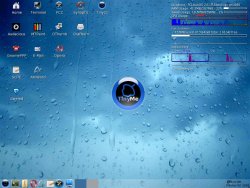Author: John Carlson
I take a sort of sick joy in using a computer as long as possible, so I’ve become interested in lightweight Linux distributions like TinyMe 2008.0 that help prolong the life of a computer. TinyMe is based on PCLinuxOS, but at about 200MB, it’s considerably smaller than that 700MB distribution. The software included, such as the Openbox window manager, is lightweight, which makes TinyMe old-hardware-friendly.
I was impressed by how nicely TinyMe installed on my 733MHz Pentium III Compaq Deskpro EN. It’s not uncommon for at least one thing to go wrong during a distro installation, but TinyMe installed perfectly. Even the optimal 1024×768 monitor resolution was right. This has been a real problem with other distros, particularly Ubuntu and its derivatives. TinyMe’s developers specify minimum system requirements of a Pentium processor and 64MB memory. They specify no disk space requirements, but a 2GB hard drive would easily hold a basic TinyMe install.
In appearance, TinyMe is attractive enough that I haven’t been tempted to change anything, which is rare for me.
TinyMe comes with a good selection of software to handle most of the basic computer tasks of today. It includes Abiword for word processing, Opera for Web browsing, Sylpheed for email, and GThumb digital camera support. However, there appears to be no included spreadsheet or database manager, and adding my printer required downloading CUPS.
Fortunately, these software problems are easily fixed. TinyMe has access to the full PCLinuxOS software library. This gives users far more choices than some other light distros, such as Puppy. Package management is handled by Synaptic, which works easily and reliably.
I must have OpenOffice.org available. I don’t use it for writing — it’s too large and cumbersome — but it’s the best open source program when it comes to supporting Microsoft Office formats. I also like to have GEdit, my favorite text editor.
With TinyMe, I was able to easily install OpenOffice, GEdit, and a few other programs. (So much for keeping TinyMe tiny!) For the most part, it went flawlessly. The only consistent problem I had was with some error messages from Synaptic that, I think, have to do with the fact that there is no KDE installation; KDE is standard for PCLinuxOS. Nevertheless, the software appeared to work normally.
The only real problem I encountered with adding software was when I tried to add LyX. Synaptic said that some software would be removed as part of its installation, including critical base software. I don’t use LyX much, so I decided I’d pass on it for the moment.
Should you ever encounter a major problem, you can get support at a forum for TinyMe.
In use, TinyMe is fast, as I’d expected. There may be faster distros out there, but TinyMe makes my old workhorse feel as fast as a newer computer running a far heavier distro.
For the most part, TinyMe is easy to use, although it’s not quite on a level with bigger distros. It takes a bit more work to set things up. My DSL Internet connection, for example, is recognized and configured automatically with bigger Linux distributions, but TinyMe requires the user do the setup using the PCLinuxOS Control Center. Configuring the Openbox window manager settings is also a little more complicated than GNOME or KDE.
Still, TinyMe is not hard to handle. Anyone who has used Linux a while should have no trouble. Even first-time users who are willing to learn something new should be able to muddle along. And once TinyMe is set up and working, pretty much anyone who knows Microsoft Windows should be able to use it.
In use, TinyMe appeared to be stable. The worst problem I’ve had has been some random glitches where icons temporarily vanishing from the desktop.
TinyMe on more limited hardware
TinyMe is a great hit on my Pentium III desktop. However, for this review, I decided I should try it on even more challenged hardware, so I dug out an old Pentium II from the back of the closet. TinyMe installed perfectly once again on this computer, which tends to be a bit cranky, particularly with power management.
I ripped out all but 64MB of memory to see if TinyMe can run with the minimum. It can, but I noticed some small problems. For example, Opera seemed to become more crash-prone. After boosting the memory back up to 192MB, the PII became as reliable as my PIII. It also runs amazingly well. It’s sluggish, but it’s never more than an “annoying” sluggish. It never became a “totally frustrating” sluggish.
Some people recondition old computers and install Linux for people who can’t afford to buy a new computer. TinyMe is a good choice for that purpose. It is fast, requires little memory and hard disk space, works reliably, and is easy to use.
I’m really impressed by TinyMe. It does an amazing job of giving “big distro usability” while keeping the system requirements low. Though I encountered some small problems, they have been no more than a minor annoyance, not a major disaster. For the right person, TinyMe is worth a serious look.
Categories:
- TinyMe
- Reviews
- Linux
- Distributions




